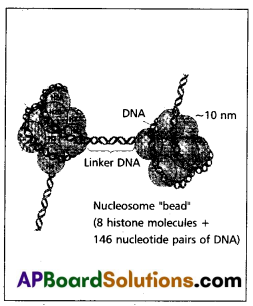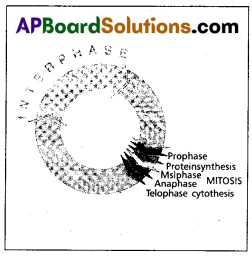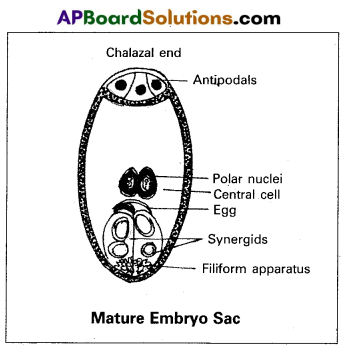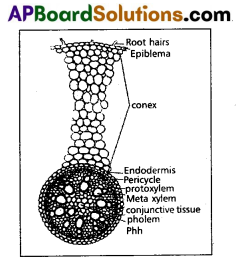Successful navigation through AP Inter 1st Year Botany Model Papers and AP Inter 1st Year Botany Question Paper March 2016 builds students’ confidence in their exam-taking abilities.
AP Inter 1st Year Botany Question Paper March 2016
Time: 3 Hours
Maximum Marks: 60
General Instructions:
Note : Read the following instructions carefully.
- Answer all questions of Section ‘A’. Answer any six questions out of eight in Section ‘B’ and answer any two questions out of three in Section – ‘C’.
- In Section ‘A’, questions from Sr. Nos. 1 to 10 are of “Very Short Answer Type”. Each question carries two marks. Every answer may be limited to five lines. Answer all the questions at one place in the same order.
- In Section ‘B’, questions from Sr. Nos. 11 to 18 are of “Short Answer Type”. Each question carries four marks. Every answer may be limited to 20 lines.
- In Section – C, questions from Sr. Nos. 19 to 21 are of “Long Answer Type”. Each question carries eight marks. Every answer may be limited to 60 lines.
- Draw labelled diagrams wherever necessary for questions in Section ‘B’ and C.
Section – A (10 × 2 = 20)
Note : Answer all questions. Each answer may be limited to 5 lines.
Question 1.
Define the terms ‘couplet’ and ‘lead’ in taxonomic key.
Answer:
The contrasting characters generally in a pair is called ‘couplet’. Each statement in the key is called ‘lead’.
Question 2.
How are viroids different from viruses ?
Answer:
| Viroids | Viruses |
| Infectious agents which contain only Nucleic acid (RNA) are called viroids. | Infectious agents which contain both Nucleic acid and protein coat are called viruses. |
| e.g : Potato spindle tuber virus. | e.g : TMV |
![]()
Question 3.
Who is popularly known as ‘Father of Botany’ ? What was the book written by him ?
Answwer:
“Theophrastus” is regarded as the Father of Botany. He wrote a book namely ‘de Historia Plantarum’.
Question 4.
What type of inflorescence1 is found in Fig trees ? Why does the insect Blastophavisits the inflorescence of Fig tree ?
Answer:
In Fig trees, ‘Hypanthodium’ Inflorescence is seen. An insect called Blastophaga’ visits this inflorescence to lay its eggs in the gall flowers.
Question 5.
Differentiate actionomorphic and zygomorphic flower.
Answer:
| Actinomorphic flower | Zygomorphic flower |
| A flower which can be cut into two equal halves in any vertical plane. e.g : Datura, Hibiscus |
A flower which can be cut into two equal halves in one vertical plane only. e.g : Bean, Cassia. |
Question 6.
What is Geocarpy ? Name the plant which exhibits this phenomenon.
Answer:
The development of fruit inside the soil is called Geocarpy. It is seen in Ground nut (Arachis hypogea).
Question 7.
What is significance of vacuole in plant cell ?
Answer:
In plants. Vacuole contains sap mainly composed of water, metabolic bye products, excretions and other waste materials. They also play an important role in osmoregulation.
![]()
Question 8.
Which tissue of animals and plants exhibits meiosis ?
Answer:
Diploid tissue (Reproductive cells).
Question 9.
An anther has 1200 pollen grains. How many pollen mother cells must have been there to produce them ?
Answer:
300 pollen mother cells.
Question 10.
Climax stage is achieved quickly in secondary succession as compared to primary succession. Why ?
Answer:
In Secondary succession, the species that invade depend on the condition of the soil, availability of water, as also the seeds or other propagules present. Since soil is already there, the rate of succession is much faster and hence climax is also reached more quickly than primary succession.
Section – B (6 × 4 = 24)
Note : Answer any six questions. Each answer may be limited to 20 lines.
Question 11.
What are the characteristic features of Euglenoids ?
Answer:
- Most of the organisms are fresh water organisms found in stagnant water.
- They have a protein rich layer called pellicle which makes the body flexible.
- They have two flagella, a short and along one.
- The anterior part of the cell bears an invagination consisting of cytostome, cytopharynx and reservoir.
- Eye spot or photosensitive stigma is presentin the membrane of reservoir.
- They behave as heterotrophs by predating on other small organisms when deprived of light.
- They reproduce by longitudinal binary fission.
Question 12.
Differentiate between Red algae and Brown algae.
Answer:
| Red algae | Brown algae |
| 1. They belong to class Rhodophyceae. | 1. They belong to class Phaeophyceae. |
| 2. Most of them are marine and some are fresh water forms. | 2. They live in fresh water, brackish and salt water. |
| 3. Cell wall made up of cellulose, pectin and polysulphate esters. | 3. Cell wall is made up of Cellulose and algin. |
| 4. The thallus is multicellular. | 4. The thallus range from simple branched filamentous forms to profusely branched . forms. |
| 5. Flagella are absent. | 5. Flagella are 2, unequal and and lateral. |
| 6. The major pigments are Chlorophyll-a, d, and r- phycoerythrin. | 6. The major pigments are Chlorophyll-a, c, carotenoids and fucoxanthin. |
| 7. Food materials are stored in the form of Floridian starch. | 7. Food materials are stored in the form of mannitol and laminarin,. |
| 8. Asexual reproduction occurs by non motile spores. | 8. Asexual reproduction occurs by biflagellate zoospores. |
| 9. Sexual reproduction is non-motile gametes. | 9. Sexual reproduction is by motile gametes. |
| 10. E.g. Polysiphonia, Porphyra. | 10. E.g.:Ectocarpus, laminaria. |
Question 13.
List the changes observed in angiosperm flower subsequent to pollination and fertilization.
Answer:
- Calyx, Corolla, Stamens, style and stigma wither away.
- Ovary develops into fruit.
- Ovules develop into seeds.
- The zygote develops into embryo.
- Primary endosperm nucleus develops into endosperm.
- The synergid and antipodals disintegrates.
- Funicle of the ovule develops into stalk of the seed.
- Integuments develop into sed coats.
- Micropyle changes into seed pore.
- Hilum changes into scar of the seed.
![]()
Question 14.
Give economic importance of plants belonging to Fabaceae.
Answer:
- Pulses like red gram (Cajanus), black gram (Phaseolus) green gram (Phaseolus aureus), Bengal gram (Cicer arientinum) are rich source of proteins.
- Pods of Dolichos and Glycine are used as vegetables.
- Seeds of Pisum and Arachis are edible.
- Ground nut oil from Arachis seeds and soyabean oil from Glycine max are used in cooking.
- The oil cake from Arachis is used as fodder.
- The oil from the seeds of Derris indica is used in making medicines.
- The seeds of Abrus precatorius are used as Goldsmith’s weight.
- Seeds of Trigonella are used as condiment and medicine. The leaves are used as vegetable.
- Sesbania and Tephrosia are used as green manure.
- Crotalaria and Phaseolus are used as fodder.
- Fibre from pterocarpus is used in making musical instruments.
- Indigofera yields blud dye, which is used in colouring clothes.
- Wood from pterocarpus is used in making musical instruments.
Question 15.
What are nudeosomes ? What are they made up of ?
Answer:
Chromatin appears as ‘beads of string. These beads are . known as known as nudeosomes. A typical
nucleosome contains 200 bp of DNA double helix wrapped around a core of histone octamer having two copies of each of four types of histone proteins i.e., H2A, H2B, H3 and H4. H1 histone lies outside the nucleosome core and seals the two turns of DNA by binding at the point where DNA enters and leaves the core. The DNA continues between two nucleosomes is called Linker DNA.

Question 16.
Though redundantly described as a resting phase, interphase does not really involve rest. Comment.
Answer:

The interphase also called phase of non apparent division though called the resting phase. It is the time during which the cell is preparing for division by undergoing cell growth and DNA replication. The interphase is divided into three further phases. They are
a. G1 phase, S-phase and G2 phase.
a. G1 Phase : It corresponds to the interval between mitosis and initiation of DNA replication. In this, the cell is metabolically active and grows continuously, RNA and Proteinsynthesis starts.
b. S-Phase : DNA replication takes place. The amount of DNA per cell doubles.
c. G2 Phase : Proteinsynthesis continues. Cell organelles increases in number. ATP synthesis necessary for spindle movement also starts in this phase.
Question 17.
State the location and function of different types of meristems.
Answer:
Based on the position, meristems are classified into three types. They are
- Apical meristems : The meristems that are present at the tip of the stem and at the tip of the root are called apical meristems. They help in linear growth of the plant body.
- Intercalary meristems : The meristems that are present in between mature tissues are known as intercalary meristems. They contribute to the formation of the primary plant body and also involves in internodal length.
- Lateral meristems : The meristems that occur in the mature regions of roots and shoots peripherally called lateral meristems. They help in increase in thickness of the plant organs, e.g : vascular cambium and Cork cambium.
![]()
Question 18.
What are Hydrophytes ? Briefly discuss “the different kinds of hydrophytes with examples.
Answer:
Plants which grow in water or in wet places are called hydrophytes. According their position in water, they are classified into five types, they are
- Free floating Hydrophytes : They float freely on water surface and have no contact with soil, e.g : Pistia, Eichhornia, Wolffia and Salvirtia.
- Rooted hydrophytes with floating leaves : Their roots are fixed in the mud but leaves have long petioles which keep them floating on the water surface. E.g: Nymphaea, NelumbO and Victoria.
- Submerged suspended hydrophytes : These plants are in contact with only water, being completely submerged and not rooted in the mud. e.g: Hydrilla, Ceratophyllum and Utricularia.
- Submerged rooted hydrophytes: These plants are completely submerged in water and attached to the substratum by their root system, e.g. Vallisneria and Potamogeton.
- Amphibious plants : These live partly in water and partly in air. e.g: Sagittaria, Ranunculus, Limnophila and Typha.
Section – C (2 × 8 = 16)
Note : Answer any two questions. Each answer may be limited to 60 lines.
Question 19.
Explain different types of racemose inflorescences.
Answer:
Racemose inflorescences are of several types.
They are
- Simple Raceme : The peduncle is simple, unbranched producing many pedicellate, bracteate flowers in acropetal manner, e.g. : Crotalaria.
- Coymb : The peduncles is long and bears many flowers in acropetal manner, but all the flowers are brought to the same level due to varied lengths of pedicels even though they are borne at different nodes, e.g. : Cassia, Cauliflower.
- Umbel : The peduncle grow indefinitely and bears several bracteate and pedicellate flowers which have arisen from the same point. The inflorescence is covered by a whorl of bracts called involucre, e.g. : Coriander, Carrot.
- Spike : The peduncle is long and bears many sessile flowers arranged in acropetal manner, e.g. : Achyranthus, Grass.
- Spadix: The peduncle is long, fleshy and bears many unisexual flowers. Male flowers are ar the upper part, Female flowers are at the base of the peduncle with neuter flowers in between them. The inflorescence is covered and protected by an enlarged bract called spathe. e.g. : Cocos, Colacasia.
- Head : the peduncle is condensed and bears many unisexual and bisexual flowers arranged centripetally. e.g. : Tridax, Sunflower.
Question 20.
With a neat labelled diagram, describe the parts of a mature angiosperm embryo sac. Mention the role of synergids.
Answer:
Mature angiosperm embryosac shows three parts. They are :
1) Egg apparatus
2) Antipodals
3) Central cell

1) Egg Apparatus : Three cells present towards the micropyle of the embryosac together called egg apparatus. Of which, the central, largest one is called egg and two lateral cells are called synergids. Synergids show finger like projections towards the micropyle called filliform apparatus.
2) Antipodals : Three cells present towards the chalazal end of the ovule are called antipodals. They are also referred to as vegetative cells of the embryosac and disintegrates before or after fertilisation.
3) Central cell : It is the largest cell of the embryosac. It is formed by the fusion of two polar nuclei. It is also called secondary nucleus. It shows central vacuole and 2 haploid polamuclei.
![]()
Question 21.
Describe the internal structure of a monocot root.
Answer:
A thin transverse section of monocot root shows three parts namely
(1) Epidermis
(2) Cortex and
(3) stele.
(i) Epidermis : It is outermost layer made up of thin walled cells. Some cells protrude in the form of unicellular root hairs, so called Epiblema. It gives protection to inner parts, cuticle and stomata are absent. Root hairs help in absorption of water and minerals from the soil.

(ii) Cortex : It consists of several hairs layered parenchymatous cells with Interecellular spaces. The Innermost layer of cortex is called Endodermis. It is the single layer made of barrel shaped cells without inter cellular spaces. The tangential as well as the radial walls of the conjunctive tissue Endodermis shows suberin thickenings called casparian strips. Some cells opposite to protoxylem are without casparian strips, called passage cells, they help in the movement of water and dissolved salts from cortex into xylem.
(iii) Stele : It is the central part of the root, consists of 4 layers.
a) Pericycle : It is single layered, made of parenchyma cells inner to Endodermis. It produces lateral roots.
b) Vascular Bundle: Xylem and phloem constitutes vascular bundle. They are arranged on different radius (in alternate manner) so called Radial vascular Bundle. Xylem is exarch, where protoxylem is towards periphery and metaxylem is towards the center, xylem is in polyarch condition (Many xylem strands). Xylem helps in conduction of water and minerals and phloem helps in conduction of food materials.
c) Medulla : It is large, made of parenchyma cells which help in storage of food.
d) Conjuctive Tissue : The parenchyma present between xylem and phloem is called conjunctive tissue. It helps in storage of food.